A Comprehensive Report on Discrimination in NHS England Employment
VerifiedAdded on 2020/07/23
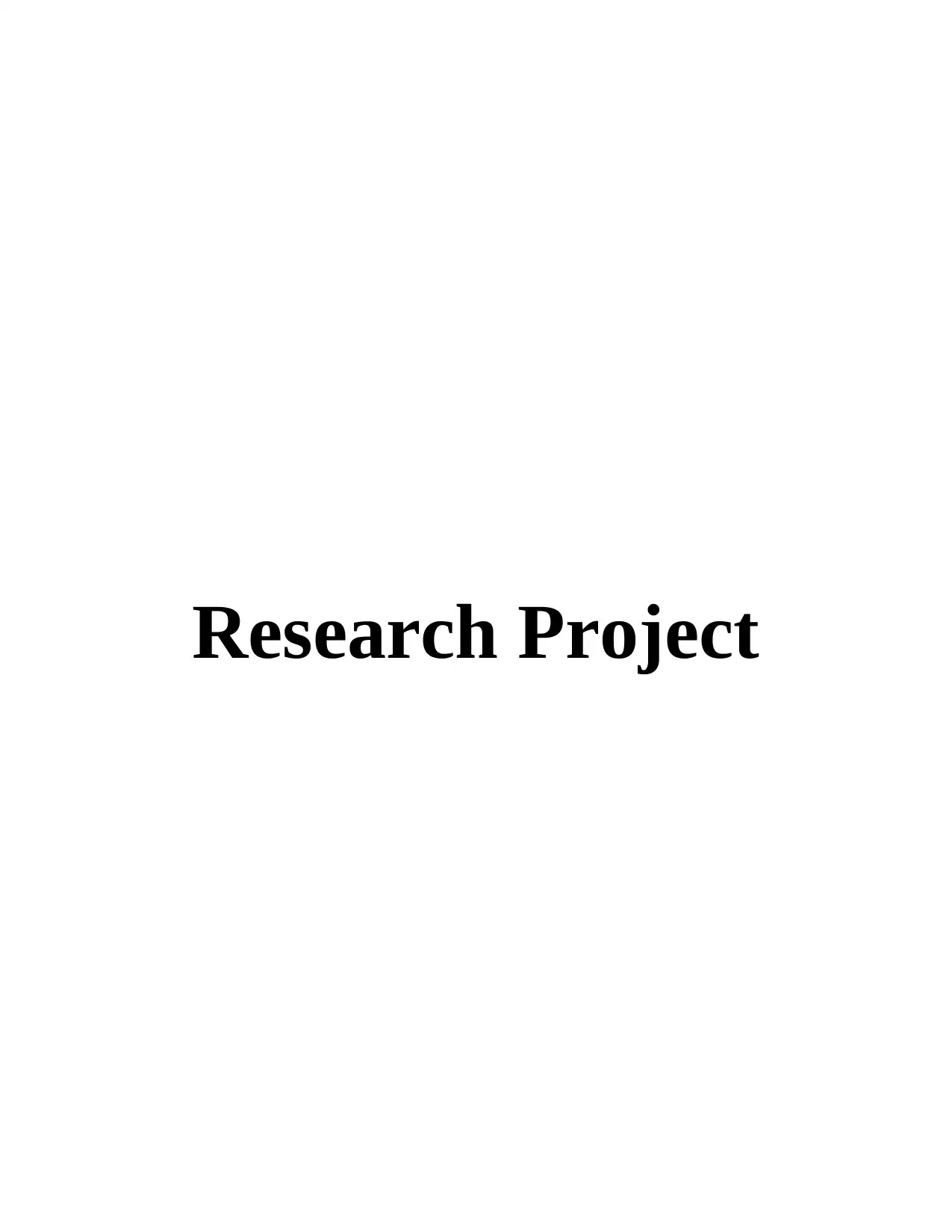
Paraphrase This Document
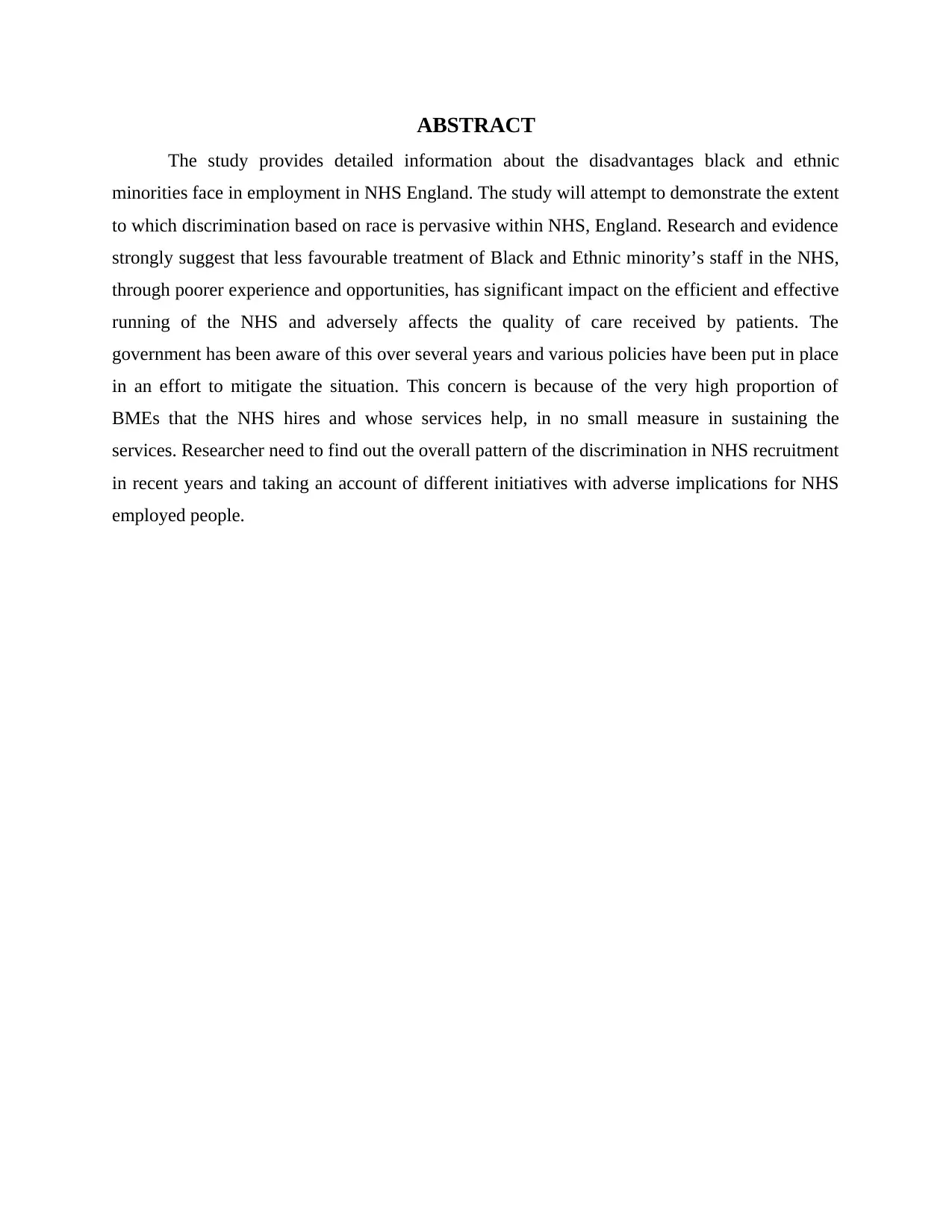
The study provides detailed information about the disadvantages black and ethnic
minorities face in employment in NHS England. The study will attempt to demonstrate the extent
to which discrimination based on race is pervasive within NHS, England. Research and evidence
strongly suggest that less favourable treatment of Black and Ethnic minority’s staff in the NHS,
through poorer experience and opportunities, has significant impact on the efficient and effective
running of the NHS and adversely affects the quality of care received by patients. The
government has been aware of this over several years and various policies have been put in place
in an effort to mitigate the situation. This concern is because of the very high proportion of
BMEs that the NHS hires and whose services help, in no small measure in sustaining the
services. Researcher need to find out the overall pattern of the discrimination in NHS recruitment
in recent years and taking an account of different initiatives with adverse implications for NHS
employed people.
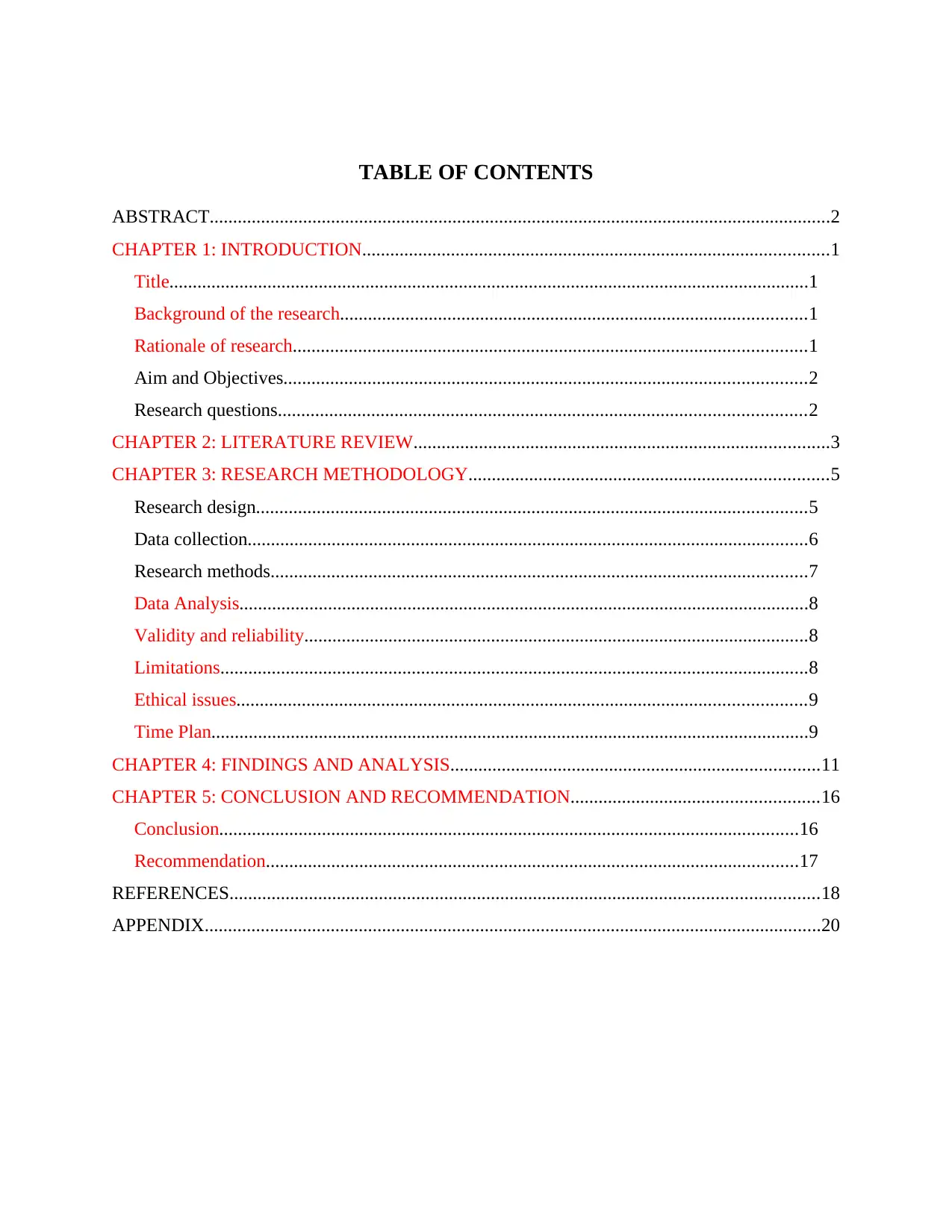
ABSTRACT.....................................................................................................................................2
CHAPTER 1: INTRODUCTION....................................................................................................1
Title.........................................................................................................................................1
Background of the research....................................................................................................1
Rationale of research..............................................................................................................1
Aim and Objectives................................................................................................................2
Research questions.................................................................................................................2
CHAPTER 2: LITERATURE REVIEW.........................................................................................3
CHAPTER 3: RESEARCH METHODOLOGY.............................................................................5
Research design......................................................................................................................5
Data collection........................................................................................................................6
Research methods...................................................................................................................7
Data Analysis..........................................................................................................................8
Validity and reliability............................................................................................................8
Limitations..............................................................................................................................8
Ethical issues..........................................................................................................................9
Time Plan................................................................................................................................9
CHAPTER 4: FINDINGS AND ANALYSIS...............................................................................11
CHAPTER 5: CONCLUSION AND RECOMMENDATION.....................................................16
Conclusion............................................................................................................................16
Recommendation..................................................................................................................17
REFERENCES..............................................................................................................................18
APPENDIX....................................................................................................................................20
⊘ This is a preview!⊘
Do you want full access?
Subscribe today to unlock all pages.

Trusted by 1+ million students worldwide
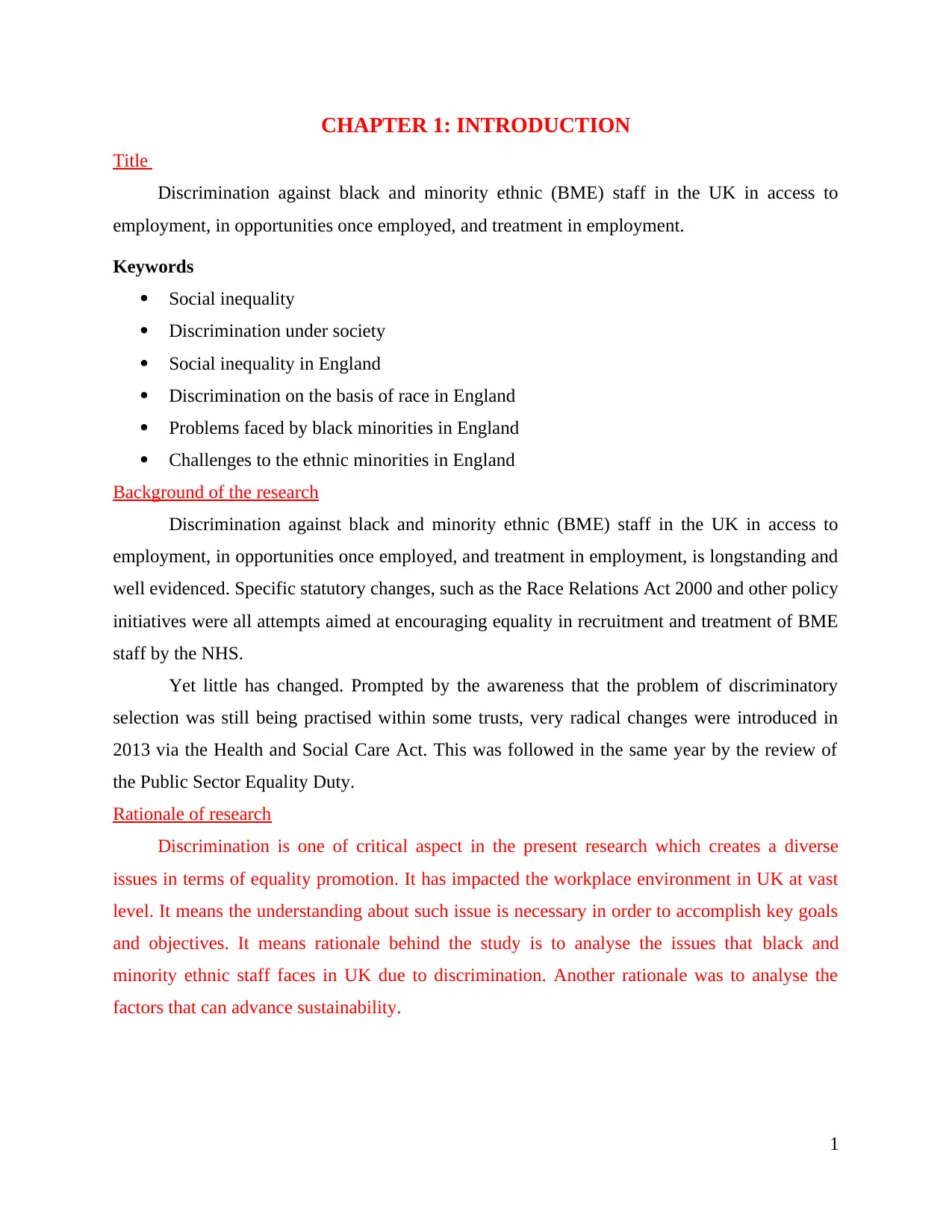
Title
Discrimination against black and minority ethnic (BME) staff in the UK in access to
employment, in opportunities once employed, and treatment in employment.
Keywords
Social inequality
Discrimination under society
Social inequality in England
Discrimination on the basis of race in England
Problems faced by black minorities in England
Challenges to the ethnic minorities in England
Background of the research
Discrimination against black and minority ethnic (BME) staff in the UK in access to
employment, in opportunities once employed, and treatment in employment, is longstanding and
well evidenced. Specific statutory changes, such as the Race Relations Act 2000 and other policy
initiatives were all attempts aimed at encouraging equality in recruitment and treatment of BME
staff by the NHS.
Yet little has changed. Prompted by the awareness that the problem of discriminatory
selection was still being practised within some trusts, very radical changes were introduced in
2013 via the Health and Social Care Act. This was followed in the same year by the review of
the Public Sector Equality Duty.
Rationale of research
Discrimination is one of critical aspect in the present research which creates a diverse
issues in terms of equality promotion. It has impacted the workplace environment in UK at vast
level. It means the understanding about such issue is necessary in order to accomplish key goals
and objectives. It means rationale behind the study is to analyse the issues that black and
minority ethnic staff faces in UK due to discrimination. Another rationale was to analyse the
factors that can advance sustainability.
1
Paraphrase This Document
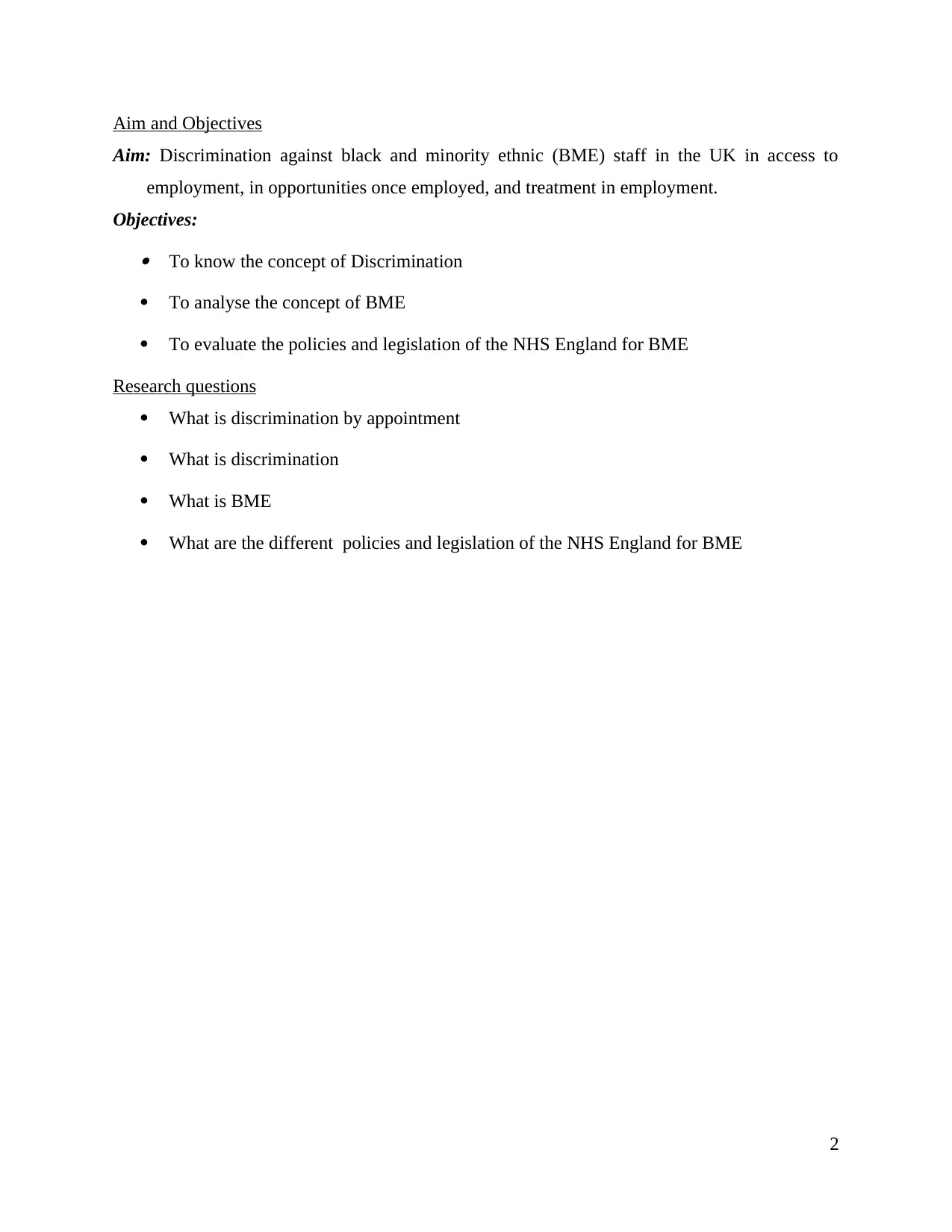
Aim: Discrimination against black and minority ethnic (BME) staff in the UK in access to
employment, in opportunities once employed, and treatment in employment.
Objectives: To know the concept of Discrimination
To analyse the concept of BME
To evaluate the policies and legislation of the NHS England for BME
Research questions
What is discrimination by appointment
What is discrimination
What is BME
What are the different policies and legislation of the NHS England for BME
2
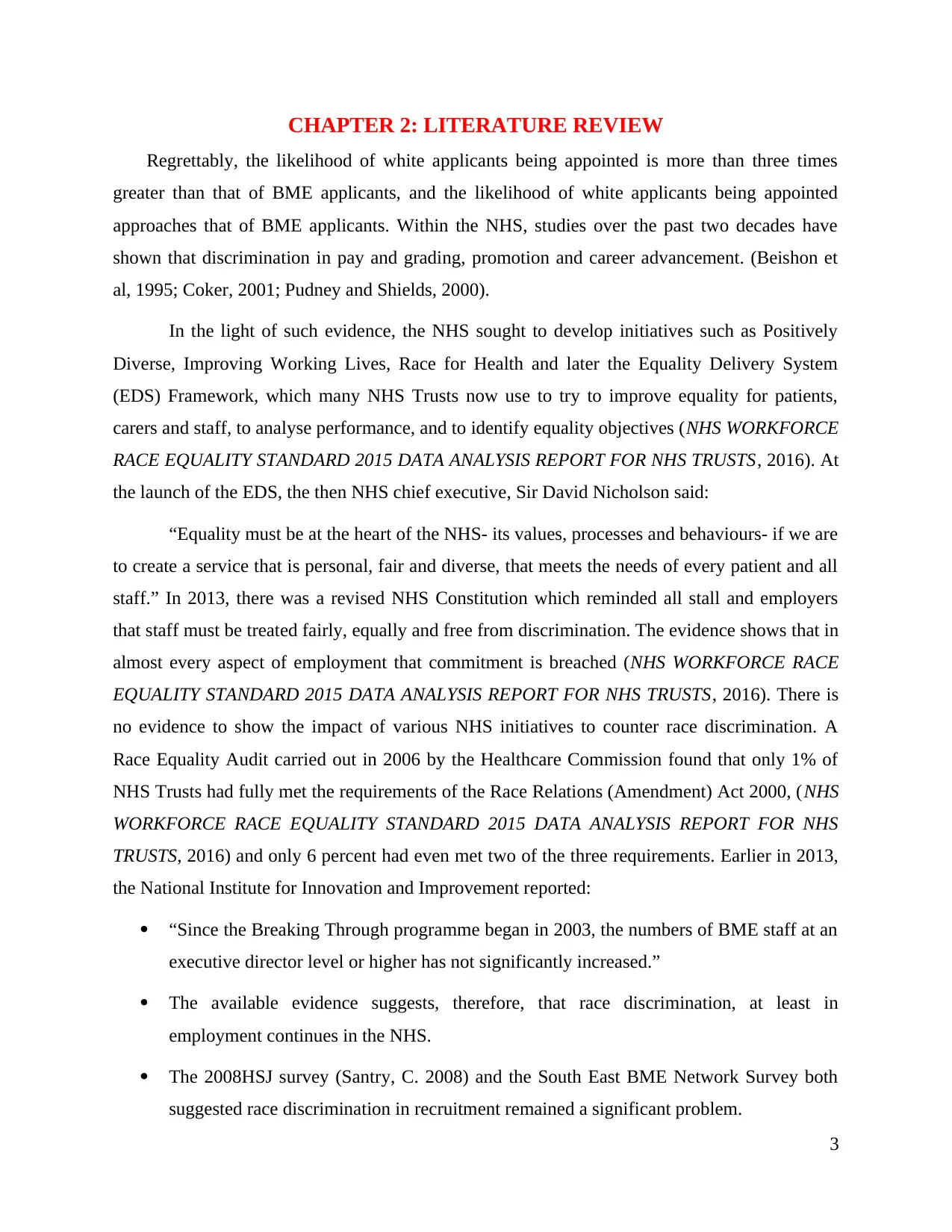
Regrettably, the likelihood of white applicants being appointed is more than three times
greater than that of BME applicants, and the likelihood of white applicants being appointed
approaches that of BME applicants. Within the NHS, studies over the past two decades have
shown that discrimination in pay and grading, promotion and career advancement. (Beishon et
al, 1995; Coker, 2001; Pudney and Shields, 2000).
In the light of such evidence, the NHS sought to develop initiatives such as Positively
Diverse, Improving Working Lives, Race for Health and later the Equality Delivery System
(EDS) Framework, which many NHS Trusts now use to try to improve equality for patients,
carers and staff, to analyse performance, and to identify equality objectives (NHS WORKFORCE
RACE EQUALITY STANDARD 2015 DATA ANALYSIS REPORT FOR NHS TRUSTS, 2016). At
the launch of the EDS, the then NHS chief executive, Sir David Nicholson said:
“Equality must be at the heart of the NHS- its values, processes and behaviours- if we are
to create a service that is personal, fair and diverse, that meets the needs of every patient and all
staff.” In 2013, there was a revised NHS Constitution which reminded all stall and employers
that staff must be treated fairly, equally and free from discrimination. The evidence shows that in
almost every aspect of employment that commitment is breached (NHS WORKFORCE RACE
EQUALITY STANDARD 2015 DATA ANALYSIS REPORT FOR NHS TRUSTS, 2016). There is
no evidence to show the impact of various NHS initiatives to counter race discrimination. A
Race Equality Audit carried out in 2006 by the Healthcare Commission found that only 1% of
NHS Trusts had fully met the requirements of the Race Relations (Amendment) Act 2000, (NHS
WORKFORCE RACE EQUALITY STANDARD 2015 DATA ANALYSIS REPORT FOR NHS
TRUSTS, 2016) and only 6 percent had even met two of the three requirements. Earlier in 2013,
the National Institute for Innovation and Improvement reported:
“Since the Breaking Through programme began in 2003, the numbers of BME staff at an
executive director level or higher has not significantly increased.”
The available evidence suggests, therefore, that race discrimination, at least in
employment continues in the NHS.
The 2008HSJ survey (Santry, C. 2008) and the South East BME Network Survey both
suggested race discrimination in recruitment remained a significant problem.
3
⊘ This is a preview!⊘
Do you want full access?
Subscribe today to unlock all pages.

Trusted by 1+ million students worldwide
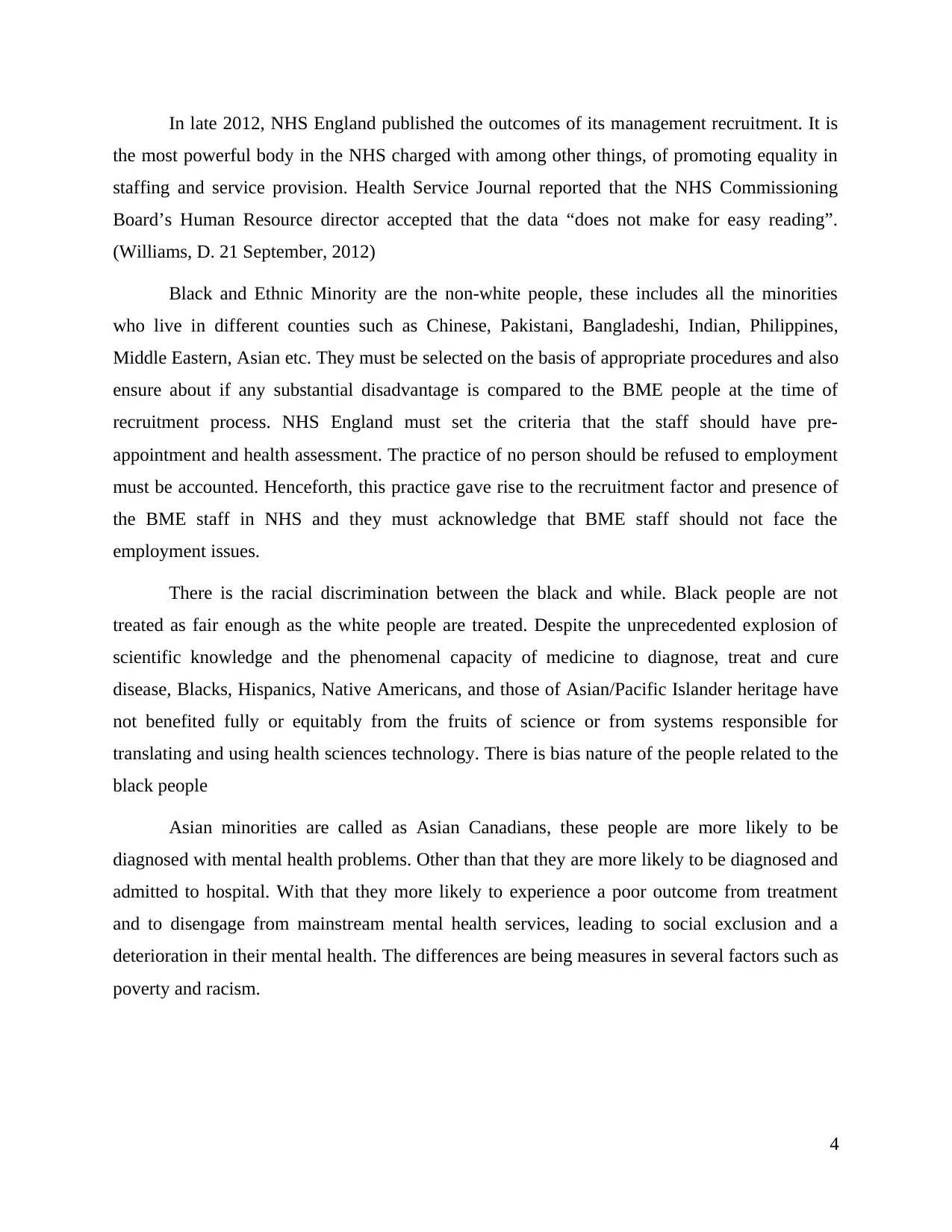
the most powerful body in the NHS charged with among other things, of promoting equality in
staffing and service provision. Health Service Journal reported that the NHS Commissioning
Board’s Human Resource director accepted that the data “does not make for easy reading”.
(Williams, D. 21 September, 2012)
Black and Ethnic Minority are the non-white people, these includes all the minorities
who live in different counties such as Chinese, Pakistani, Bangladeshi, Indian, Philippines,
Middle Eastern, Asian etc. They must be selected on the basis of appropriate procedures and also
ensure about if any substantial disadvantage is compared to the BME people at the time of
recruitment process. NHS England must set the criteria that the staff should have pre-
appointment and health assessment. The practice of no person should be refused to employment
must be accounted. Henceforth, this practice gave rise to the recruitment factor and presence of
the BME staff in NHS and they must acknowledge that BME staff should not face the
employment issues.
There is the racial discrimination between the black and while. Black people are not
treated as fair enough as the white people are treated. Despite the unprecedented explosion of
scientific knowledge and the phenomenal capacity of medicine to diagnose, treat and cure
disease, Blacks, Hispanics, Native Americans, and those of Asian/Pacific Islander heritage have
not benefited fully or equitably from the fruits of science or from systems responsible for
translating and using health sciences technology. There is bias nature of the people related to the
black people
Asian minorities are called as Asian Canadians, these people are more likely to be
diagnosed with mental health problems. Other than that they are more likely to be diagnosed and
admitted to hospital. With that they more likely to experience a poor outcome from treatment
and to disengage from mainstream mental health services, leading to social exclusion and a
deterioration in their mental health. The differences are being measures in several factors such as
poverty and racism.
4
Paraphrase This Document
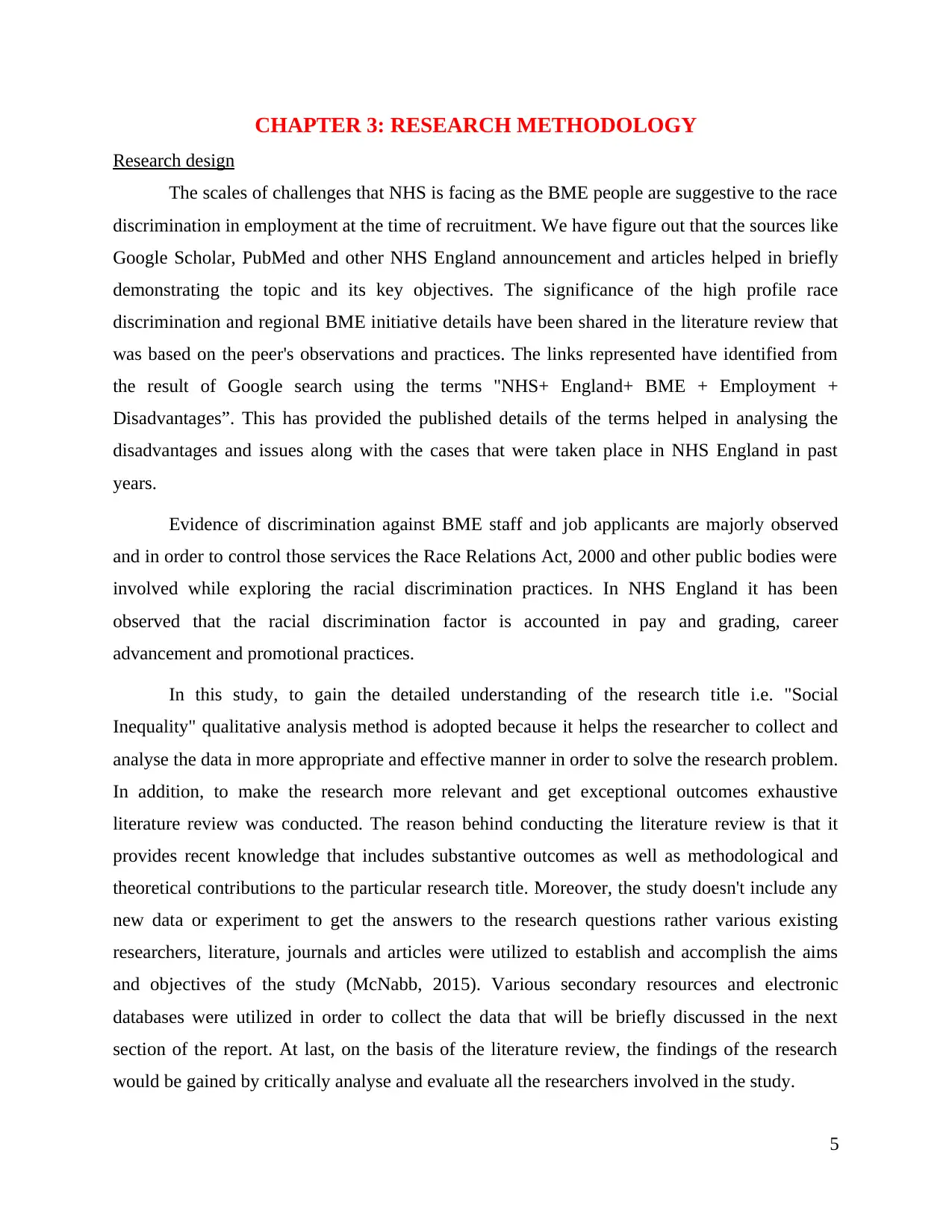
Research design
The scales of challenges that NHS is facing as the BME people are suggestive to the race
discrimination in employment at the time of recruitment. We have figure out that the sources like
Google Scholar, PubMed and other NHS England announcement and articles helped in briefly
demonstrating the topic and its key objectives. The significance of the high profile race
discrimination and regional BME initiative details have been shared in the literature review that
was based on the peer's observations and practices. The links represented have identified from
the result of Google search using the terms "NHS+ England+ BME + Employment +
Disadvantages”. This has provided the published details of the terms helped in analysing the
disadvantages and issues along with the cases that were taken place in NHS England in past
years.
Evidence of discrimination against BME staff and job applicants are majorly observed
and in order to control those services the Race Relations Act, 2000 and other public bodies were
involved while exploring the racial discrimination practices. In NHS England it has been
observed that the racial discrimination factor is accounted in pay and grading, career
advancement and promotional practices.
In this study, to gain the detailed understanding of the research title i.e. "Social
Inequality" qualitative analysis method is adopted because it helps the researcher to collect and
analyse the data in more appropriate and effective manner in order to solve the research problem.
In addition, to make the research more relevant and get exceptional outcomes exhaustive
literature review was conducted. The reason behind conducting the literature review is that it
provides recent knowledge that includes substantive outcomes as well as methodological and
theoretical contributions to the particular research title. Moreover, the study doesn't include any
new data or experiment to get the answers to the research questions rather various existing
researchers, literature, journals and articles were utilized to establish and accomplish the aims
and objectives of the study (McNabb, 2015). Various secondary resources and electronic
databases were utilized in order to collect the data that will be briefly discussed in the next
section of the report. At last, on the basis of the literature review, the findings of the research
would be gained by critically analyse and evaluate all the researchers involved in the study.
5
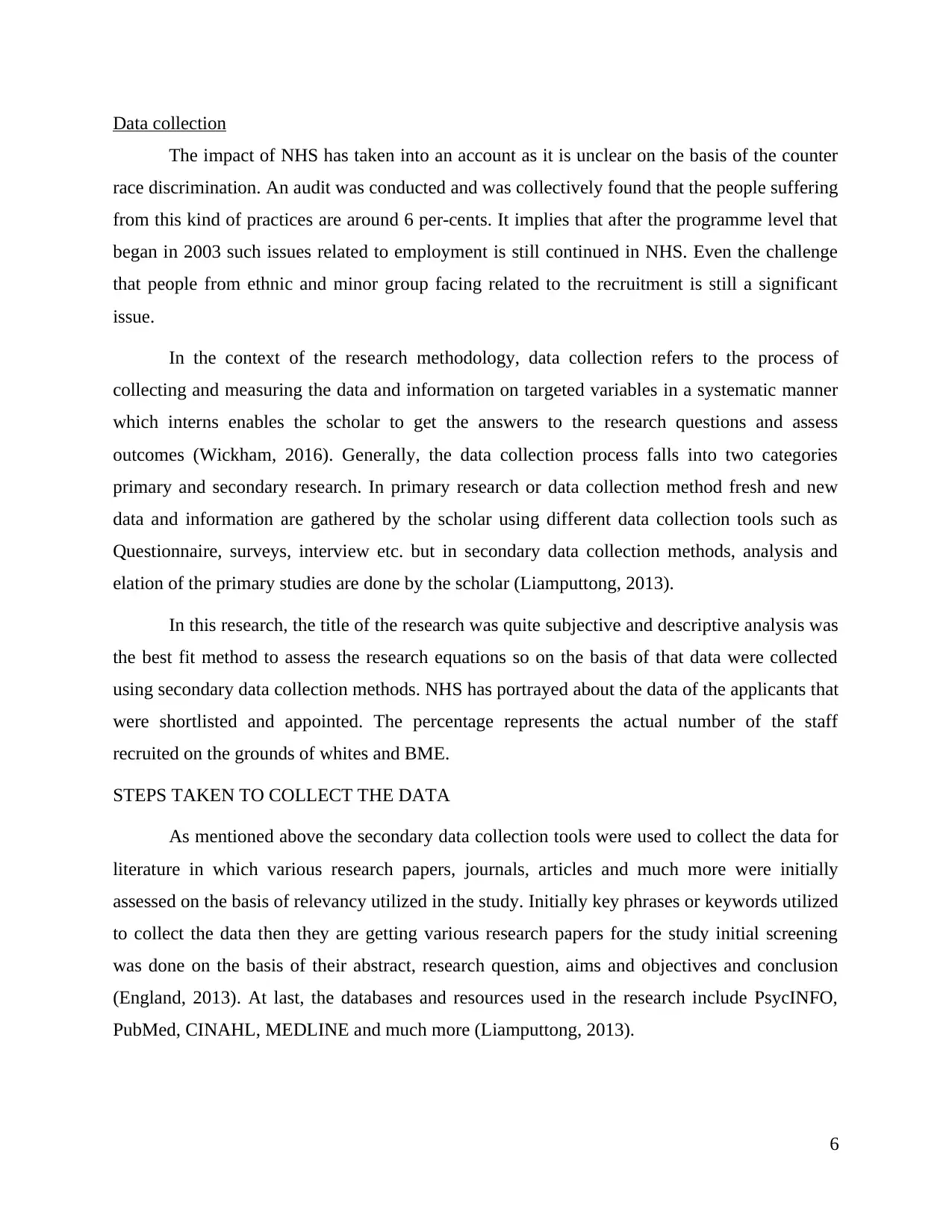
The impact of NHS has taken into an account as it is unclear on the basis of the counter
race discrimination. An audit was conducted and was collectively found that the people suffering
from this kind of practices are around 6 per-cents. It implies that after the programme level that
began in 2003 such issues related to employment is still continued in NHS. Even the challenge
that people from ethnic and minor group facing related to the recruitment is still a significant
issue.
In the context of the research methodology, data collection refers to the process of
collecting and measuring the data and information on targeted variables in a systematic manner
which interns enables the scholar to get the answers to the research questions and assess
outcomes (Wickham, 2016). Generally, the data collection process falls into two categories
primary and secondary research. In primary research or data collection method fresh and new
data and information are gathered by the scholar using different data collection tools such as
Questionnaire, surveys, interview etc. but in secondary data collection methods, analysis and
elation of the primary studies are done by the scholar (Liamputtong, 2013).
In this research, the title of the research was quite subjective and descriptive analysis was
the best fit method to assess the research equations so on the basis of that data were collected
using secondary data collection methods. NHS has portrayed about the data of the applicants that
were shortlisted and appointed. The percentage represents the actual number of the staff
recruited on the grounds of whites and BME.
STEPS TAKEN TO COLLECT THE DATA
As mentioned above the secondary data collection tools were used to collect the data for
literature in which various research papers, journals, articles and much more were initially
assessed on the basis of relevancy utilized in the study. Initially key phrases or keywords utilized
to collect the data then they are getting various research papers for the study initial screening
was done on the basis of their abstract, research question, aims and objectives and conclusion
(England, 2013). At last, the databases and resources used in the research include PsycINFO,
PubMed, CINAHL, MEDLINE and much more (Liamputtong, 2013).
6
⊘ This is a preview!⊘
Do you want full access?
Subscribe today to unlock all pages.

Trusted by 1+ million students worldwide

NHS England has around 162 acute trusts and around them, research has been made that
is provided to the peer observations and on the basis of the literature review that the terms of the
number of white and BME applicants and shortlisted candidates and appointees to vacancies in
past year is studied. The data available are:
Beyond 2010
Presenting number of percentages
It includes the BME and whites applicants appointed and shortlisted details as to judge
the disadvantages factors
Further, it has included the data of full year and also some of them on monthly and
quarterly basis
The analysis of the data has been consequently boosted up in upgrading the policies and
legislation of the NHS England and to carry out the effective research on the subject we have to
follow the secondary research methodologies in order to present a suitable outcome of the study.
The research has projected on the following points:
Discrimination issue still present in the NHS working environment (NHS WORKFORCE
RACE EQUALITY STANDARD 2015 DATA ANALYSIS REPORT FOR NHS TRUSTS,
2016).
Percentage of the discrimination among BME staff and White staff appointed
Awareness among the staff based on Equality and Diversity training
An effective research is carried out throughout the research proposal that has allied
different aspects of the treatment of the black and ethnic minorities in the NHS England. It has
been moped up with the statistic that represented current situation of the subject. Further,
different approaches were formulated to identify the issues that are the concern with the topic
(McNabb, 2015). The researcher have selected the qualitative analysis to collect and analyse the
data. Therefore, secondary research was carried and the data is collected from the different
sources such as sources of journals and literature. The questionnaires were distributed in order to
represent the current statistic of the NHS England. Feedbacks were recorded and strategies
including different laws and legislation were developed so as to minimise the issues that were
7
Paraphrase This Document
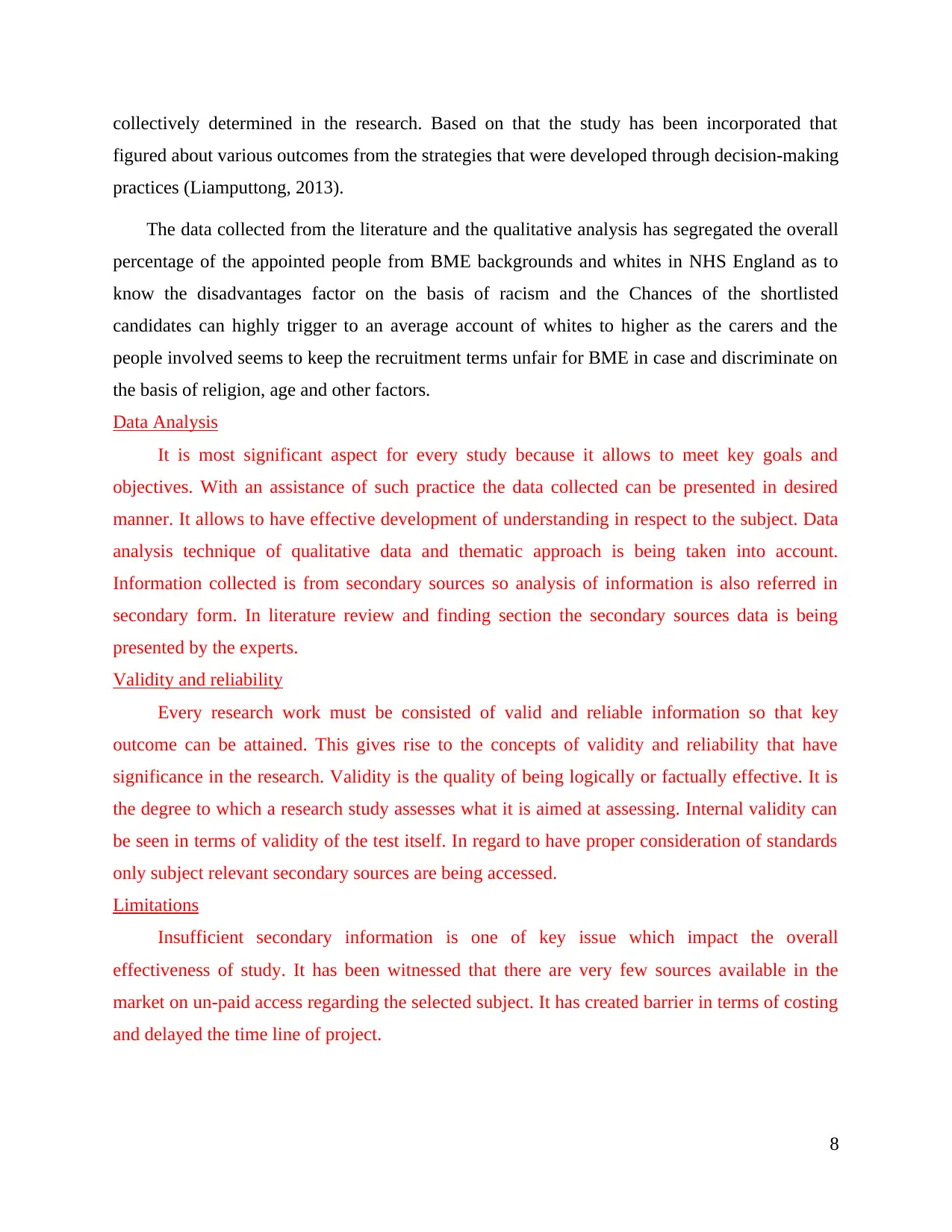
figured about various outcomes from the strategies that were developed through decision-making
practices (Liamputtong, 2013).
The data collected from the literature and the qualitative analysis has segregated the overall
percentage of the appointed people from BME backgrounds and whites in NHS England as to
know the disadvantages factor on the basis of racism and the Chances of the shortlisted
candidates can highly trigger to an average account of whites to higher as the carers and the
people involved seems to keep the recruitment terms unfair for BME in case and discriminate on
the basis of religion, age and other factors.
Data Analysis
It is most significant aspect for every study because it allows to meet key goals and
objectives. With an assistance of such practice the data collected can be presented in desired
manner. It allows to have effective development of understanding in respect to the subject. Data
analysis technique of qualitative data and thematic approach is being taken into account.
Information collected is from secondary sources so analysis of information is also referred in
secondary form. In literature review and finding section the secondary sources data is being
presented by the experts.
Validity and reliability
Every research work must be consisted of valid and reliable information so that key
outcome can be attained. This gives rise to the concepts of validity and reliability that have
significance in the research. Validity is the quality of being logically or factually effective. It is
the degree to which a research study assesses what it is aimed at assessing. Internal validity can
be seen in terms of validity of the test itself. In regard to have proper consideration of standards
only subject relevant secondary sources are being accessed.
Limitations
Insufficient secondary information is one of key issue which impact the overall
effectiveness of study. It has been witnessed that there are very few sources available in the
market on un-paid access regarding the selected subject. It has created barrier in terms of costing
and delayed the time line of project.
8
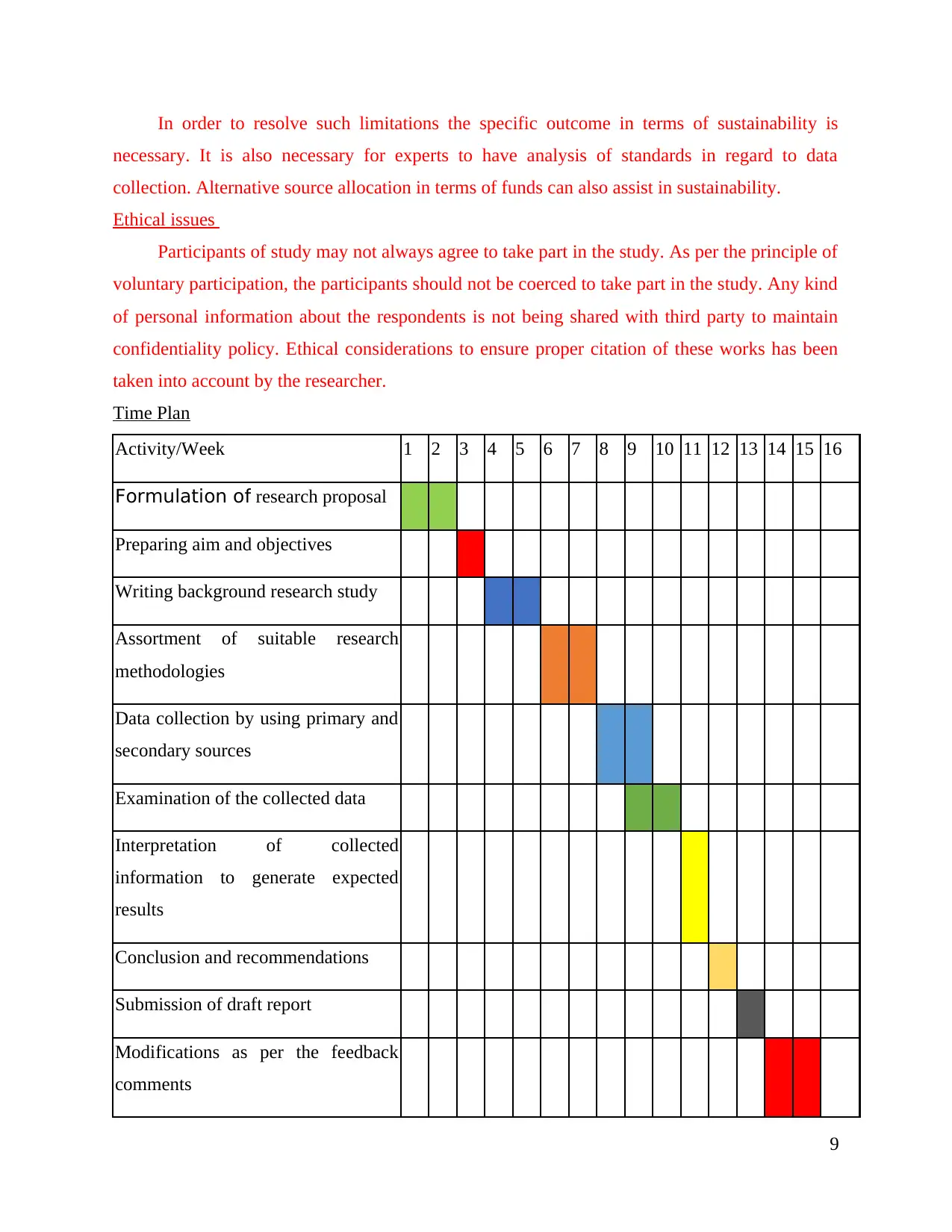
necessary. It is also necessary for experts to have analysis of standards in regard to data
collection. Alternative source allocation in terms of funds can also assist in sustainability.
Ethical issues
Participants of study may not always agree to take part in the study. As per the principle of
voluntary participation, the participants should not be coerced to take part in the study. Any kind
of personal information about the respondents is not being shared with third party to maintain
confidentiality policy. Ethical considerations to ensure proper citation of these works has been
taken into account by the researcher.
Time Plan
Activity/Week 1 2 3 4 5 6 7 8 9 10 11 12 13 14 15 16
Formulation of research proposal
Preparing aim and objectives
Writing background research study
Assortment of suitable research
methodologies
Data collection by using primary and
secondary sources
Examination of the collected data
Interpretation of collected
information to generate expected
results
Conclusion and recommendations
Submission of draft report
Modifications as per the feedback
comments
9
⊘ This is a preview!⊘
Do you want full access?
Subscribe today to unlock all pages.

Trusted by 1+ million students worldwide

10
Paraphrase This Document

Racial discrimination is the possible reason for Whites being the majority of top
management staff in the NHS. The Study provides the different factor responsible for the staff
facing social inequality properties. However, it seems to be unlikely to explain the entire
differential and certainly cannot mark the remarkable finding and shortlisting and appointed
applicants results as per post.
The report that covers all the NHS trusts attitudes towards the black and ethnic minority
staff has observed that they are been bullied and harassed than their white colleagues
(WORKFORCE RACE EQUALITY REPORT, 2017). It has also been said that the percentage
of the BME workers are higher than white colleagues which includes all the departments of NHS
accident and emergency and maternity and around 75 percent are bullied, abused or harassed by
the staff. The level of harassment from the point of view that is practised in public and NHS are
broadly similar for BME and Non-BME staff (WORKFORCE RACE EQUALITY REPORT,
2017).
There is split in NHS England that describes the racial and workforce differences in both
the staff in the clinical and non-clinical section can be targeted as to measure the racial
discrimination in the entire NHS. It was found that the discrimination on the basis of the
workforce is the higher variance of 1 per-cent than in BME group. The proportion of the white
staff is higher and represents around 82.6 per-cents. However, the overall workforce triggered to
be 79.4 per-cents for the white and only 20.6 per-cent of BME.
The analysis of the BME and Whites in NHS has been represented that depicts the current
scenario of the shortcomings of the recruitment practices in the NHS England. A comparative
result is presented that provides a clear indication of the appointed and shortlisted candidates in
NHS (WORKFORCE RACE EQUALITY REPORT, 2017).
The result was found that the candidates that belong to the BME races are reportedly
lower than the white. The conventional epitomes have been practised through by the NHS that
has focused on terms of social inequalities in the past years (Bartley, 2016). They have
formulated the new law that has been practised to malicious activity.
11
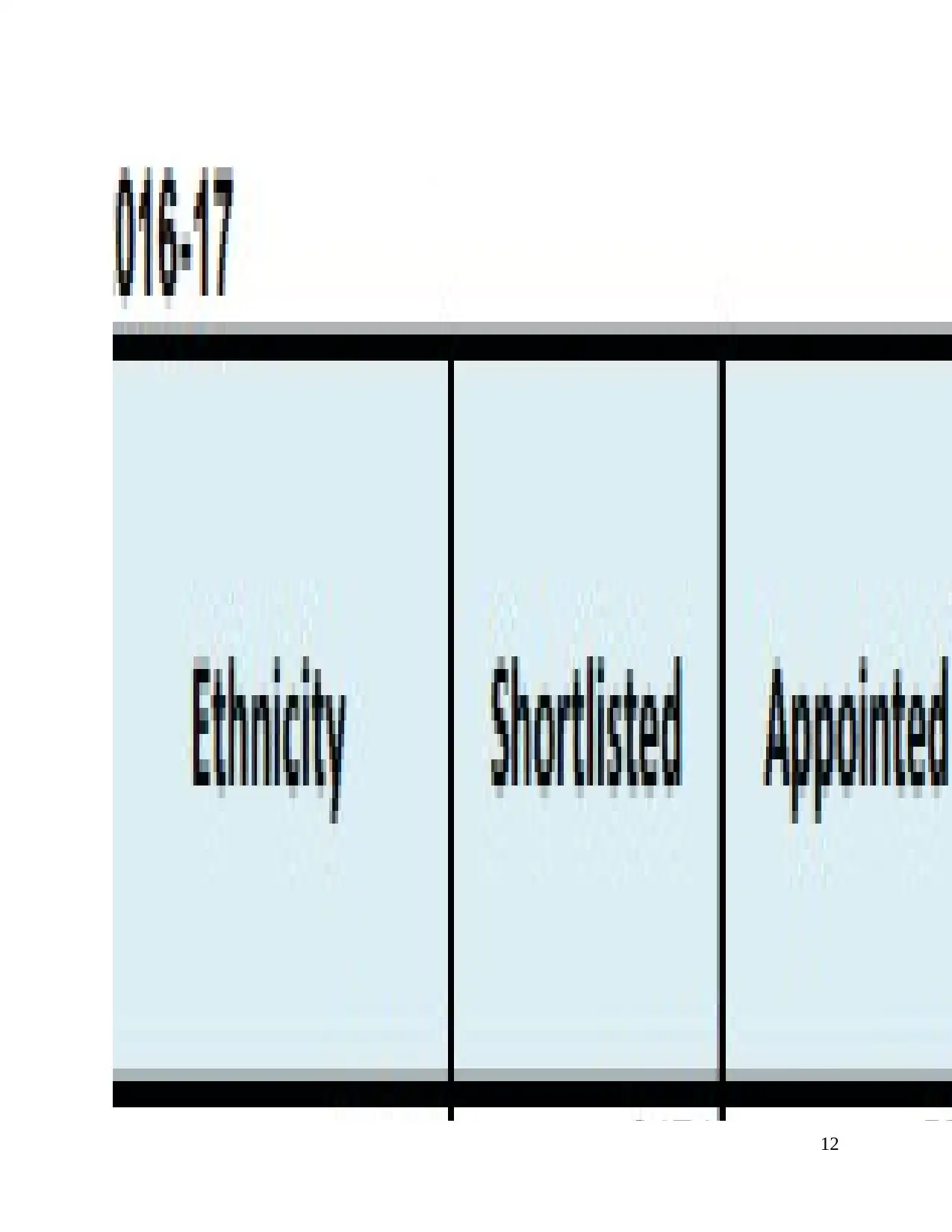
⊘ This is a preview!⊘
Do you want full access?
Subscribe today to unlock all pages.

Trusted by 1+ million students worldwide
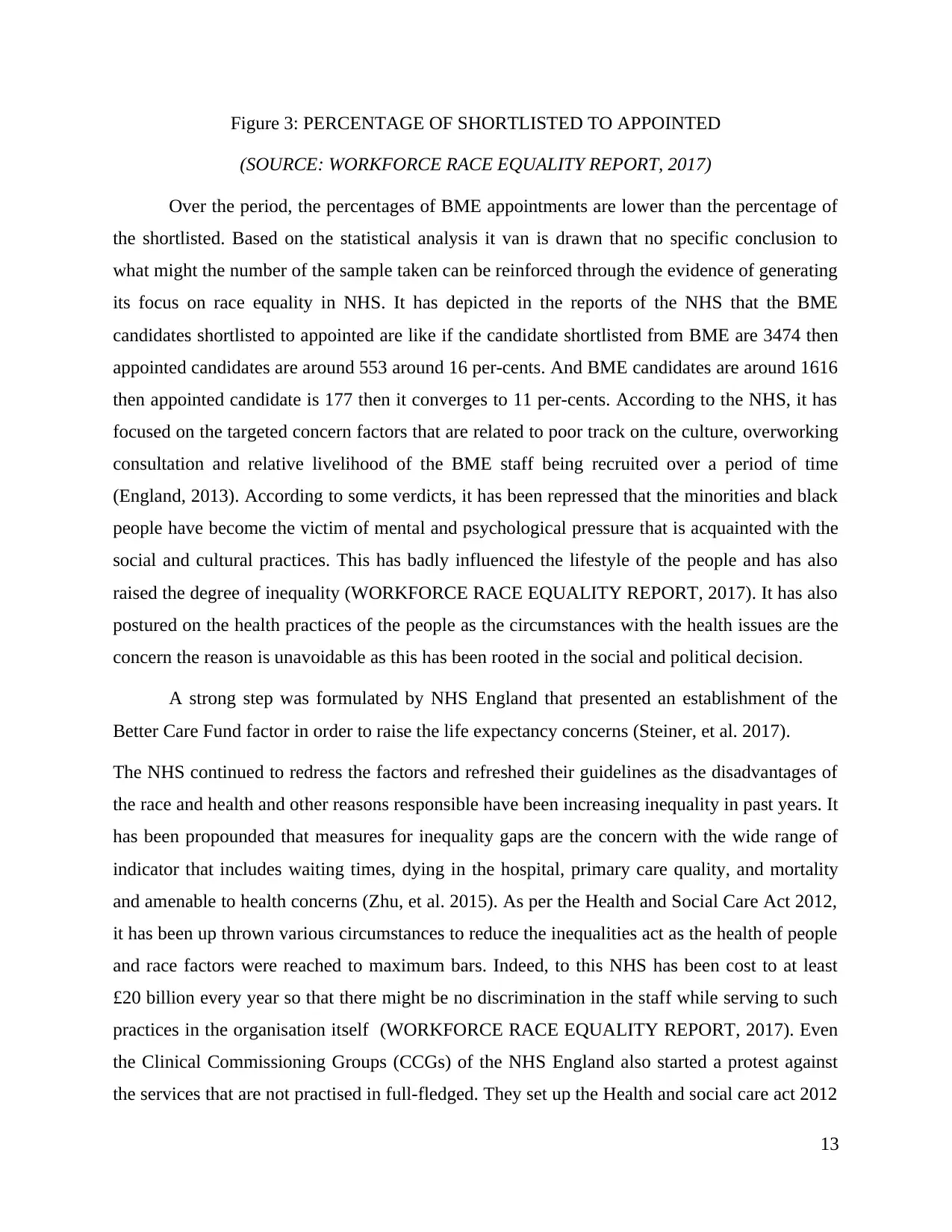
(SOURCE: WORKFORCE RACE EQUALITY REPORT, 2017)
Over the period, the percentages of BME appointments are lower than the percentage of
the shortlisted. Based on the statistical analysis it van is drawn that no specific conclusion to
what might the number of the sample taken can be reinforced through the evidence of generating
its focus on race equality in NHS. It has depicted in the reports of the NHS that the BME
candidates shortlisted to appointed are like if the candidate shortlisted from BME are 3474 then
appointed candidates are around 553 around 16 per-cents. And BME candidates are around 1616
then appointed candidate is 177 then it converges to 11 per-cents. According to the NHS, it has
focused on the targeted concern factors that are related to poor track on the culture, overworking
consultation and relative livelihood of the BME staff being recruited over a period of time
(England, 2013). According to some verdicts, it has been repressed that the minorities and black
people have become the victim of mental and psychological pressure that is acquainted with the
social and cultural practices. This has badly influenced the lifestyle of the people and has also
raised the degree of inequality (WORKFORCE RACE EQUALITY REPORT, 2017). It has also
postured on the health practices of the people as the circumstances with the health issues are the
concern the reason is unavoidable as this has been rooted in the social and political decision.
A strong step was formulated by NHS England that presented an establishment of the
Better Care Fund factor in order to raise the life expectancy concerns (Steiner, et al. 2017).
The NHS continued to redress the factors and refreshed their guidelines as the disadvantages of
the race and health and other reasons responsible have been increasing inequality in past years. It
has been propounded that measures for inequality gaps are the concern with the wide range of
indicator that includes waiting times, dying in the hospital, primary care quality, and mortality
and amenable to health concerns (Zhu, et al. 2015). As per the Health and Social Care Act 2012,
it has been up thrown various circumstances to reduce the inequalities act as the health of people
and race factors were reached to maximum bars. Indeed, to this NHS has been cost to at least
£20 billion every year so that there might be no discrimination in the staff while serving to such
practices in the organisation itself (WORKFORCE RACE EQUALITY REPORT, 2017). Even
the Clinical Commissioning Groups (CCGs) of the NHS England also started a protest against
the services that are not practised in full-fledged. They set up the Health and social care act 2012
13
Paraphrase This Document
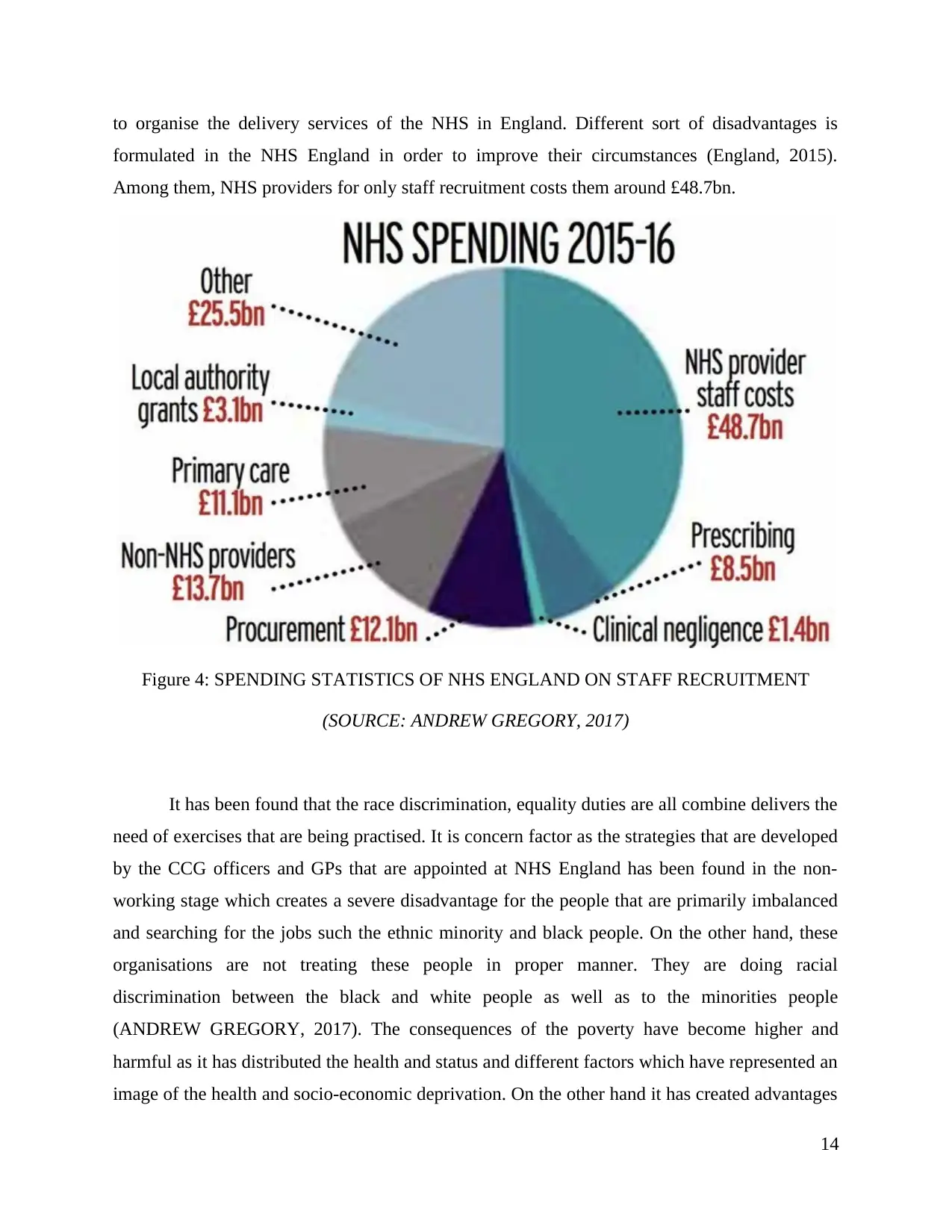
formulated in the NHS England in order to improve their circumstances (England, 2015).
Among them, NHS providers for only staff recruitment costs them around £48.7bn.
Figure 4: SPENDING STATISTICS OF NHS ENGLAND ON STAFF RECRUITMENT
(SOURCE: ANDREW GREGORY, 2017)
It has been found that the race discrimination, equality duties are all combine delivers the
need of exercises that are being practised. It is concern factor as the strategies that are developed
by the CCG officers and GPs that are appointed at NHS England has been found in the non-
working stage which creates a severe disadvantage for the people that are primarily imbalanced
and searching for the jobs such the ethnic minority and black people. On the other hand, these
organisations are not treating these people in proper manner. They are doing racial
discrimination between the black and white people as well as to the minorities people
(ANDREW GREGORY, 2017). The consequences of the poverty have become higher and
harmful as it has distributed the health and status and different factors which have represented an
image of the health and socio-economic deprivation. On the other hand it has created advantages
14
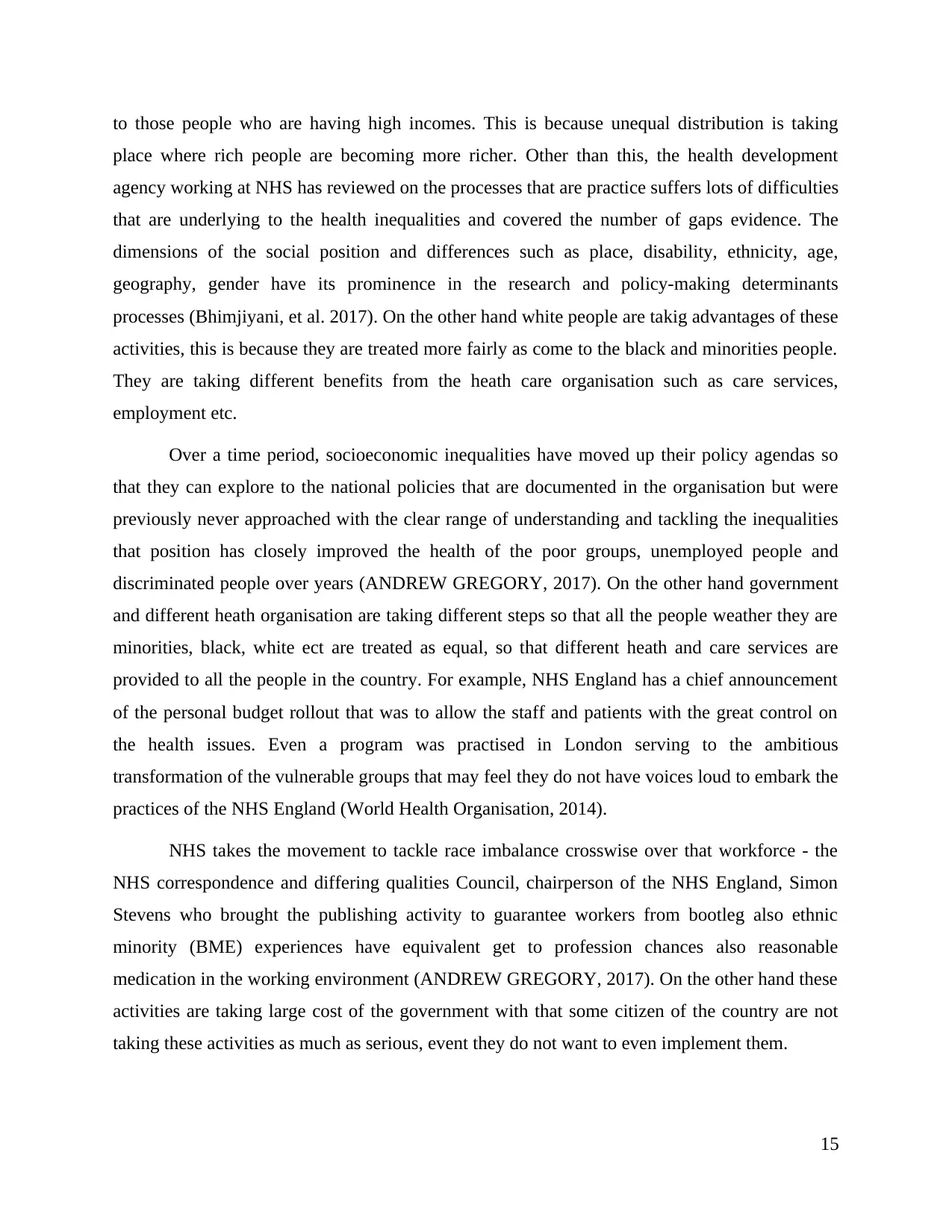
place where rich people are becoming more richer. Other than this, the health development
agency working at NHS has reviewed on the processes that are practice suffers lots of difficulties
that are underlying to the health inequalities and covered the number of gaps evidence. The
dimensions of the social position and differences such as place, disability, ethnicity, age,
geography, gender have its prominence in the research and policy-making determinants
processes (Bhimjiyani, et al. 2017). On the other hand white people are takig advantages of these
activities, this is because they are treated more fairly as come to the black and minorities people.
They are taking different benefits from the heath care organisation such as care services,
employment etc.
Over a time period, socioeconomic inequalities have moved up their policy agendas so
that they can explore to the national policies that are documented in the organisation but were
previously never approached with the clear range of understanding and tackling the inequalities
that position has closely improved the health of the poor groups, unemployed people and
discriminated people over years (ANDREW GREGORY, 2017). On the other hand government
and different heath organisation are taking different steps so that all the people weather they are
minorities, black, white ect are treated as equal, so that different heath and care services are
provided to all the people in the country. For example, NHS England has a chief announcement
of the personal budget rollout that was to allow the staff and patients with the great control on
the health issues. Even a program was practised in London serving to the ambitious
transformation of the vulnerable groups that may feel they do not have voices loud to embark the
practices of the NHS England (World Health Organisation, 2014).
NHS takes the movement to tackle race imbalance crosswise over that workforce - the
NHS correspondence and differing qualities Council, chairperson of the NHS England, Simon
Stevens who brought the publishing activity to guarantee workers from bootleg also ethnic
minority (BME) experiences have equivalent get to profession chances also reasonable
medication in the working environment (ANDREW GREGORY, 2017). On the other hand these
activities are taking large cost of the government with that some citizen of the country are not
taking these activities as much as serious, event they do not want to even implement them.
15
⊘ This is a preview!⊘
Do you want full access?
Subscribe today to unlock all pages.

Trusted by 1+ million students worldwide
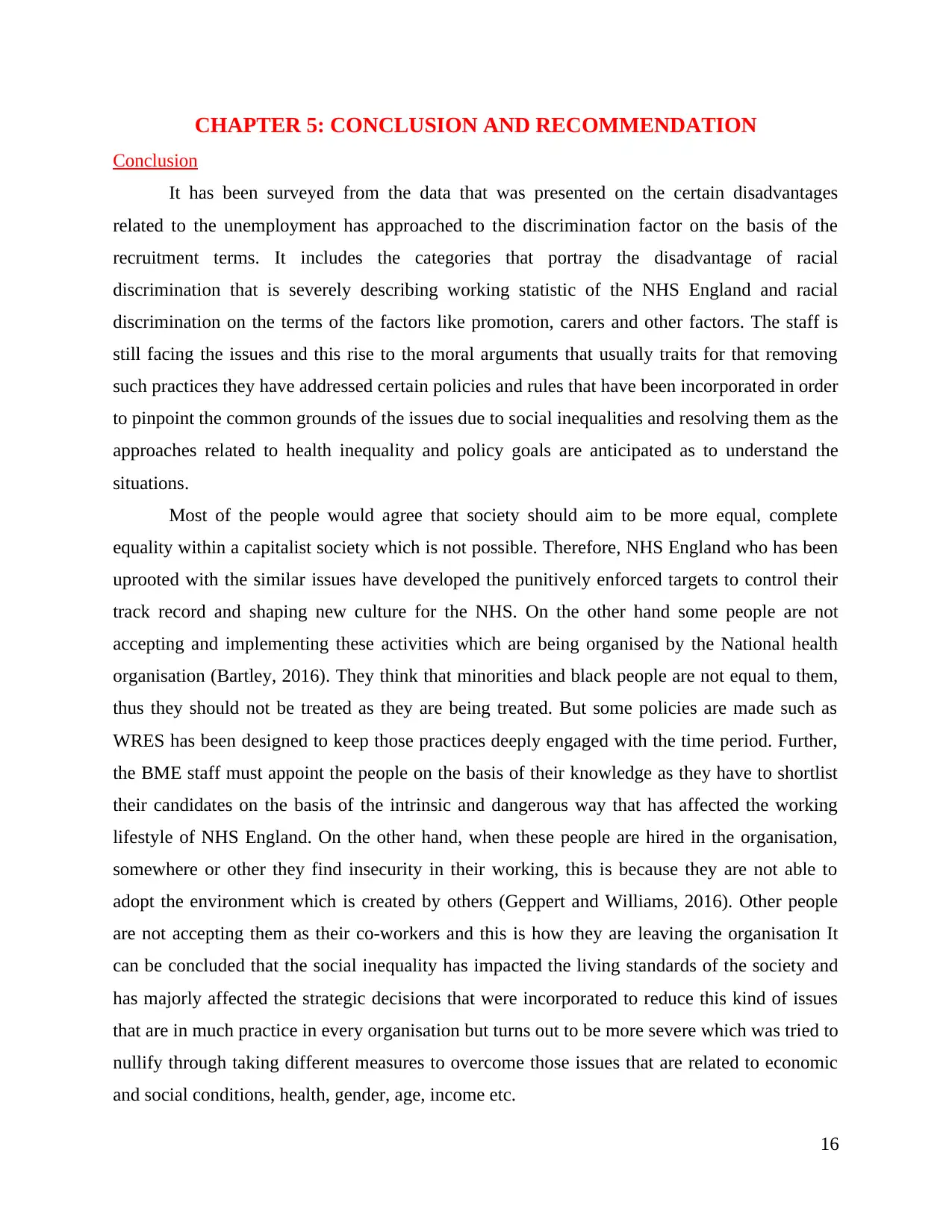
Conclusion
It has been surveyed from the data that was presented on the certain disadvantages
related to the unemployment has approached to the discrimination factor on the basis of the
recruitment terms. It includes the categories that portray the disadvantage of racial
discrimination that is severely describing working statistic of the NHS England and racial
discrimination on the terms of the factors like promotion, carers and other factors. The staff is
still facing the issues and this rise to the moral arguments that usually traits for that removing
such practices they have addressed certain policies and rules that have been incorporated in order
to pinpoint the common grounds of the issues due to social inequalities and resolving them as the
approaches related to health inequality and policy goals are anticipated as to understand the
situations.
Most of the people would agree that society should aim to be more equal, complete
equality within a capitalist society which is not possible. Therefore, NHS England who has been
uprooted with the similar issues have developed the punitively enforced targets to control their
track record and shaping new culture for the NHS. On the other hand some people are not
accepting and implementing these activities which are being organised by the National health
organisation (Bartley, 2016). They think that minorities and black people are not equal to them,
thus they should not be treated as they are being treated. But some policies are made such as
WRES has been designed to keep those practices deeply engaged with the time period. Further,
the BME staff must appoint the people on the basis of their knowledge as they have to shortlist
their candidates on the basis of the intrinsic and dangerous way that has affected the working
lifestyle of NHS England. On the other hand, when these people are hired in the organisation,
somewhere or other they find insecurity in their working, this is because they are not able to
adopt the environment which is created by others (Geppert and Williams, 2016). Other people
are not accepting them as their co-workers and this is how they are leaving the organisation It
can be concluded that the social inequality has impacted the living standards of the society and
has majorly affected the strategic decisions that were incorporated to reduce this kind of issues
that are in much practice in every organisation but turns out to be more severe which was tried to
nullify through taking different measures to overcome those issues that are related to economic
and social conditions, health, gender, age, income etc.
16
Paraphrase This Document
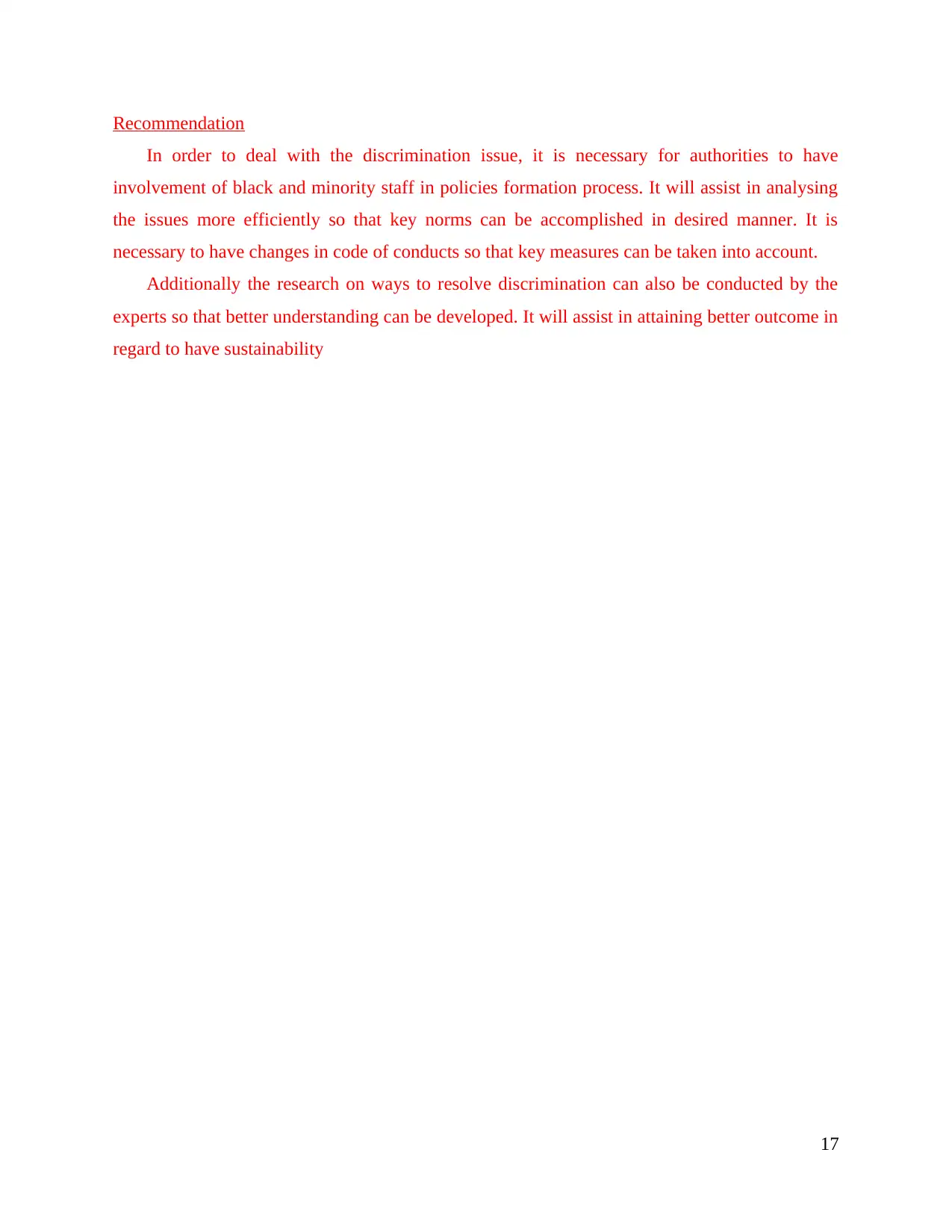
In order to deal with the discrimination issue, it is necessary for authorities to have
involvement of black and minority staff in policies formation process. It will assist in analysing
the issues more efficiently so that key norms can be accomplished in desired manner. It is
necessary to have changes in code of conducts so that key measures can be taken into account.
Additionally the research on ways to resolve discrimination can also be conducted by the
experts so that better understanding can be developed. It will assist in attaining better outcome in
regard to have sustainability
17
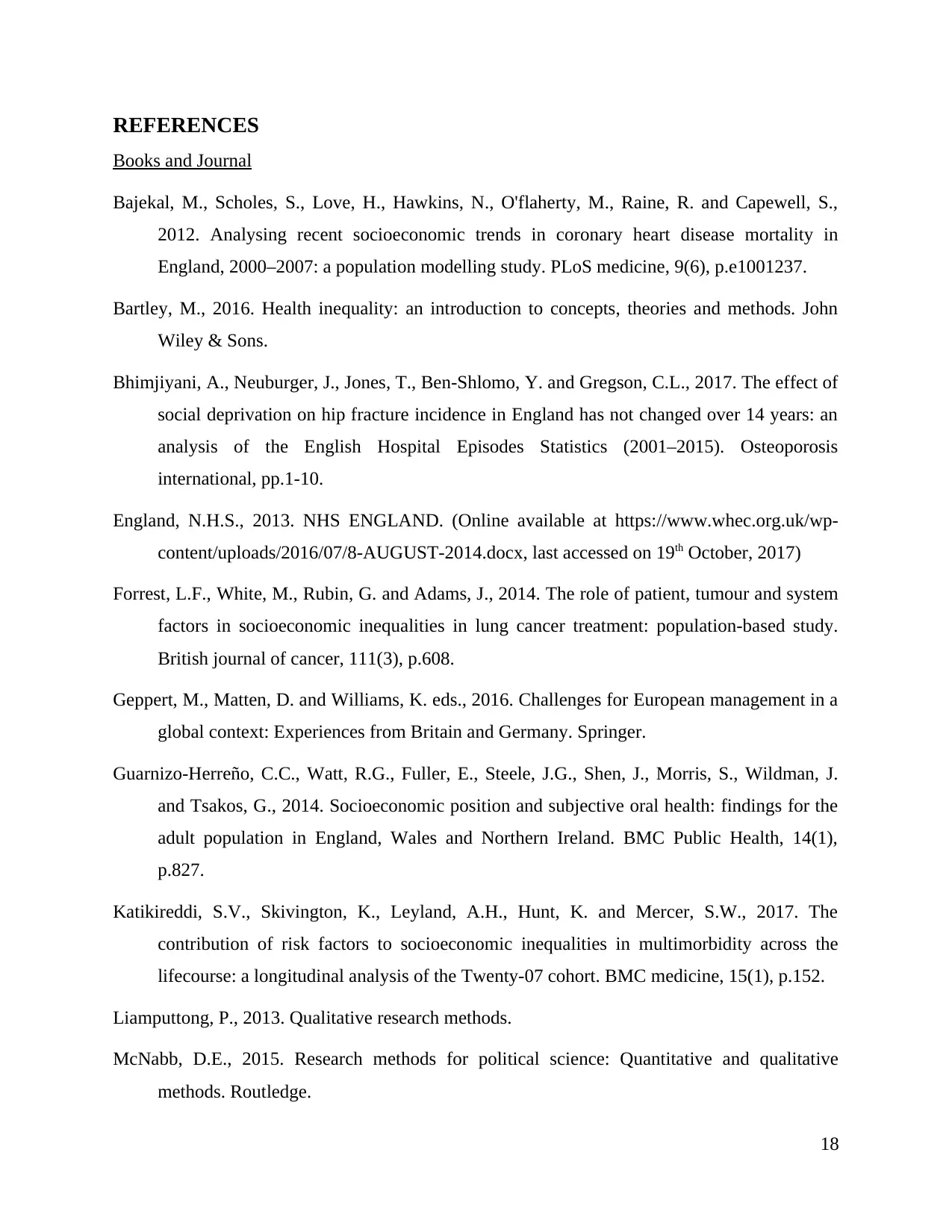
Books and Journal
Bajekal, M., Scholes, S., Love, H., Hawkins, N., O'flaherty, M., Raine, R. and Capewell, S.,
2012. Analysing recent socioeconomic trends in coronary heart disease mortality in
England, 2000–2007: a population modelling study. PLoS medicine, 9(6), p.e1001237.
Bartley, M., 2016. Health inequality: an introduction to concepts, theories and methods. John
Wiley & Sons.
Bhimjiyani, A., Neuburger, J., Jones, T., Ben-Shlomo, Y. and Gregson, C.L., 2017. The effect of
social deprivation on hip fracture incidence in England has not changed over 14 years: an
analysis of the English Hospital Episodes Statistics (2001–2015). Osteoporosis
international, pp.1-10.
England, N.H.S., 2013. NHS ENGLAND. (Online available at https://www.whec.org.uk/wp-
content/uploads/2016/07/8-AUGUST-2014.docx, last accessed on 19th October, 2017)
Forrest, L.F., White, M., Rubin, G. and Adams, J., 2014. The role of patient, tumour and system
factors in socioeconomic inequalities in lung cancer treatment: population-based study.
British journal of cancer, 111(3), p.608.
Geppert, M., Matten, D. and Williams, K. eds., 2016. Challenges for European management in a
global context: Experiences from Britain and Germany. Springer.
Guarnizo-Herreño, C.C., Watt, R.G., Fuller, E., Steele, J.G., Shen, J., Morris, S., Wildman, J.
and Tsakos, G., 2014. Socioeconomic position and subjective oral health: findings for the
adult population in England, Wales and Northern Ireland. BMC Public Health, 14(1),
p.827.
Katikireddi, S.V., Skivington, K., Leyland, A.H., Hunt, K. and Mercer, S.W., 2017. The
contribution of risk factors to socioeconomic inequalities in multimorbidity across the
lifecourse: a longitudinal analysis of the Twenty-07 cohort. BMC medicine, 15(1), p.152.
Liamputtong, P., 2013. Qualitative research methods.
McNabb, D.E., 2015. Research methods for political science: Quantitative and qualitative
methods. Routledge.
18
⊘ This is a preview!⊘
Do you want full access?
Subscribe today to unlock all pages.

Trusted by 1+ million students worldwide
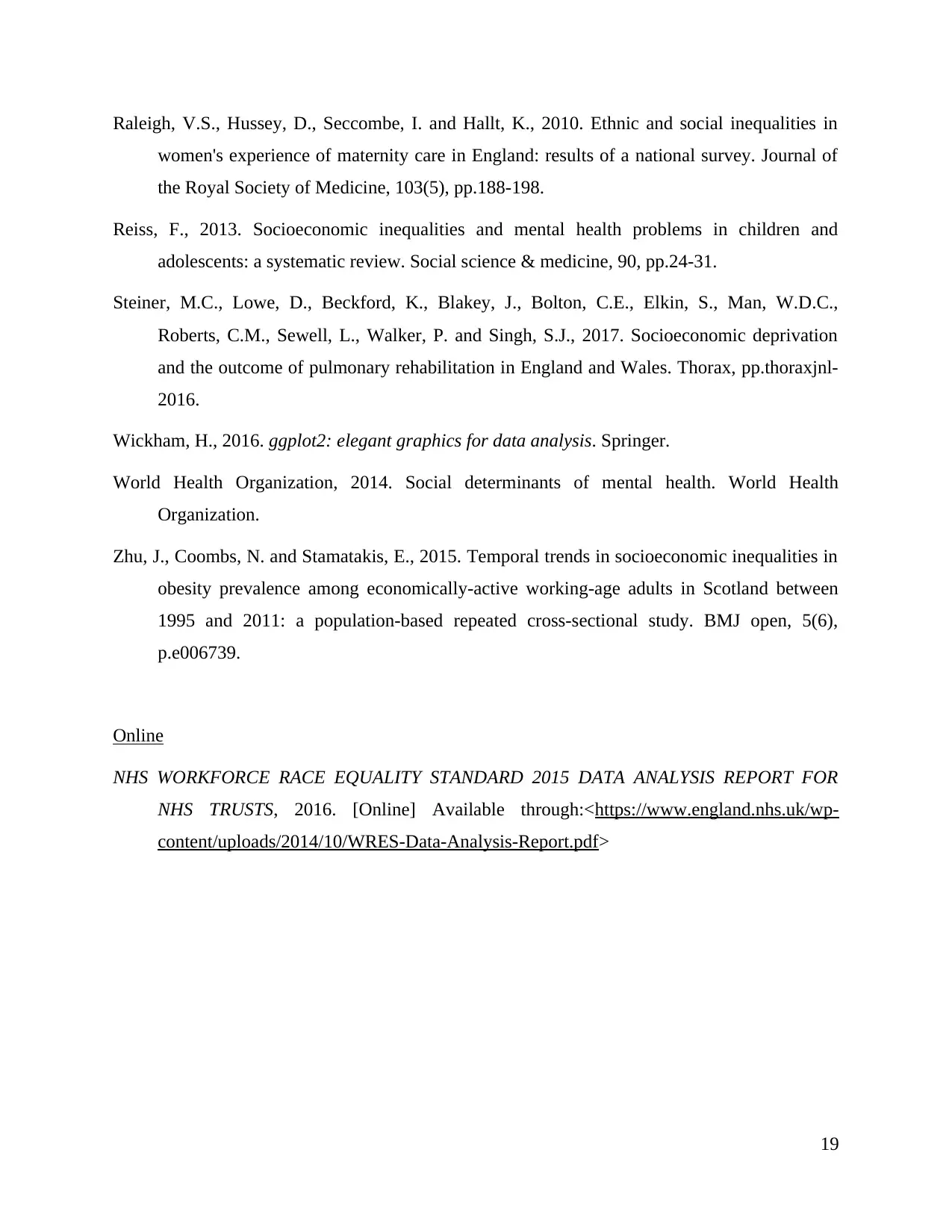
women's experience of maternity care in England: results of a national survey. Journal of
the Royal Society of Medicine, 103(5), pp.188-198.
Reiss, F., 2013. Socioeconomic inequalities and mental health problems in children and
adolescents: a systematic review. Social science & medicine, 90, pp.24-31.
Steiner, M.C., Lowe, D., Beckford, K., Blakey, J., Bolton, C.E., Elkin, S., Man, W.D.C.,
Roberts, C.M., Sewell, L., Walker, P. and Singh, S.J., 2017. Socioeconomic deprivation
and the outcome of pulmonary rehabilitation in England and Wales. Thorax, pp.thoraxjnl-
2016.
Wickham, H., 2016. ggplot2: elegant graphics for data analysis. Springer.
World Health Organization, 2014. Social determinants of mental health. World Health
Organization.
Zhu, J., Coombs, N. and Stamatakis, E., 2015. Temporal trends in socioeconomic inequalities in
obesity prevalence among economically-active working-age adults in Scotland between
1995 and 2011: a population-based repeated cross-sectional study. BMJ open, 5(6),
p.e006739.
Online
NHS WORKFORCE RACE EQUALITY STANDARD 2015 DATA ANALYSIS REPORT FOR
NHS TRUSTS, 2016. [Online] Available through:<https://www.england.nhs.uk/wp-
content/uploads/2014/10/WRES-Data-Analysis-Report.pdf>
19
Paraphrase This Document
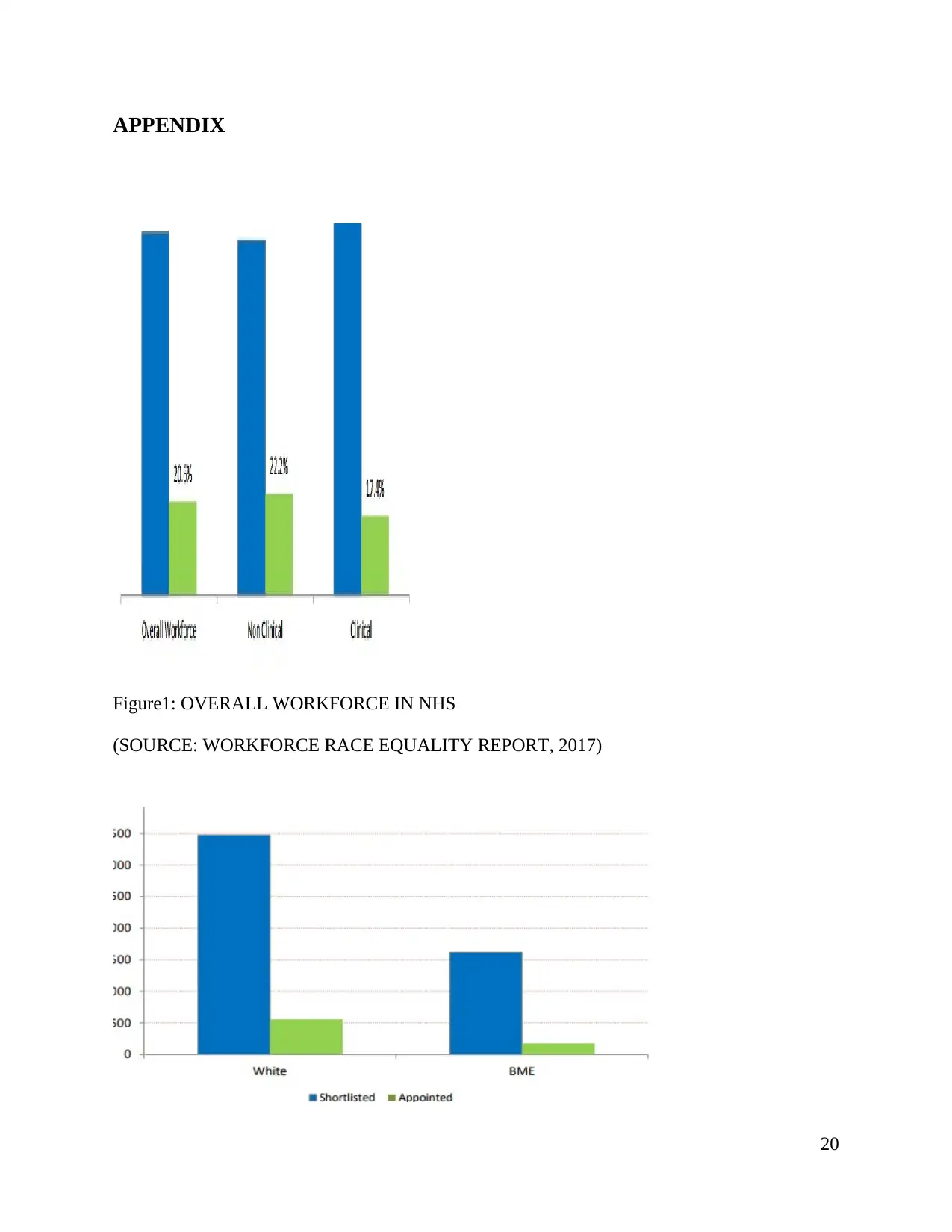
Figure1: OVERALL WORKFORCE IN NHS
(SOURCE: WORKFORCE RACE EQUALITY REPORT, 2017)
20
Related Documents
Your All-in-One AI-Powered Toolkit for Academic Success.
+13062052269
info@desklib.com
Available 24*7 on WhatsApp / Email
![[object Object]](/_next/static/media/star-bottom.7253800d.svg)
© 2024 | Zucol Services PVT LTD | All rights reserved.





